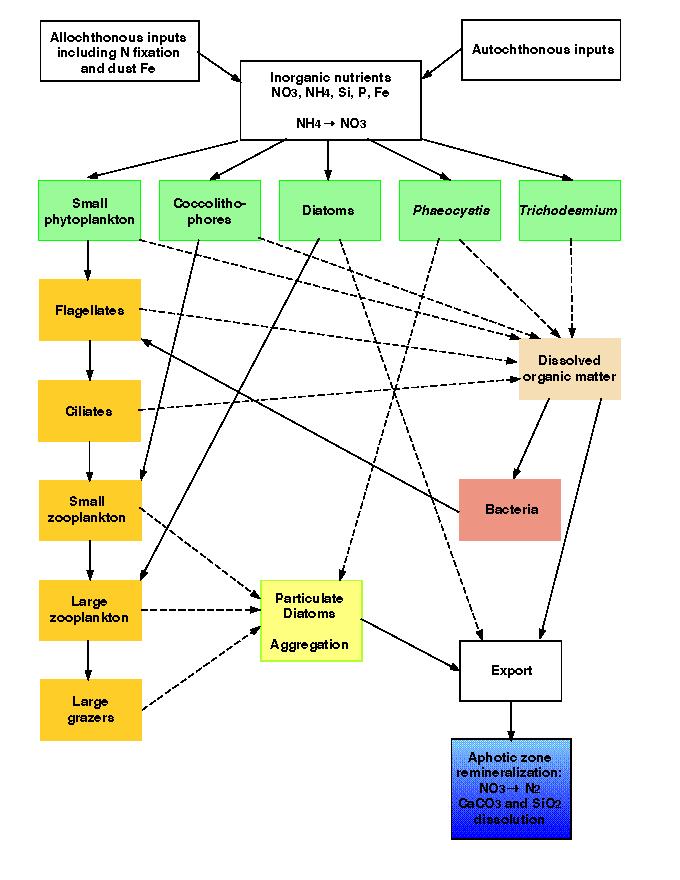
Group Leaders: Hugh Ducklow, Mike Roman, Ed Laws
Objectives:
Background:
Progress:
The Foodweb Working Group met several times to consider priority tasks in the SMP. Two themes emerged:
As a start, we resolved to begin collecting information on foodweb
stocks and flows, for formal analysis. Examples of foodweb analyses
can be found in the references appended.
Information will be provided by volunteers with expertise in particular trophic groups and/or JGOFS study sites. The units of analysis will be integrated carbon and nitrogen stocks/fluxes in the euphotic zone (mmol C or N m-2 [d-1] ) for the following sites and time periods. We will set up a separate webpage in the future (via this web page) where files can be exchanged and accessed.
Sites and Times:
| NABE | 47N, 20W station | April and May 1989 cruises |
| EQPAC | 0N, 140W | the 4 time series and survey cruises in 1992 |
| Arabian Sea | Stations S1-S7 (averaged)
S8-S14 (averaged) |
NE and SW Monsoons |
| Ross Sea | central "Phaeocystis region" along 76.5S | November, December 1994-97
January, February 1996-98 |
| AESOPS | APFZ sites ??? | |
| BATS | annual means? | |
| Station P | ??? |
Data should be submitted in Excel files. Successive Excel sheets within
a file could include: the "raw" data from discrete depths and dates from
which integrals and averages were derived; the averaged integral quantities,
etc. I will work with Joanie Kleypas and put an example up soon (e.g.,
Dick Dugdale's model EQPAC files). The various
references
below
provide suggested compartments and flows for analysis.
Food web group model development
The SMP food web group concluded that the model presented in Figure
1 was a good starting point from which to test the descriptive/predictive
abilities of prognostic models relative to the goals of the SMP.
The first goal of the model development is to identify differential equations
to describe the fluxes in the model. These differential equations
can then be incorporated into a one-dimensional physical model so that
the behavior of the model can be examined in the regional test beds.
Tasks:
Group assignments are as follows:
| Bacteria | Anderson, T; Ducklow | Nutrients | Carr; Deutsch; Falkowski; Follows; Gruber; Loukos |
| CaCO3 | Kleypas | Physical models | Anderson, L; Chai; DeConto; Deutsch; Gruber; Najjar; Verschell |
| Data | Bates; Frost; Laws | Phytoplankton | Carr; Barber; DiTullio; Iglesias-Rodriguez; Laws; Lindsay; Lizotte; Loukas; Moore |
| Detritus, DOM | Anderson, L; Jackson; Najjar | Remineralization | Gruber; Bates; Carr; Deutsch; Falkowski; Gruber; Kleypas |
| Margins | Falkowski | Zooplankton | Frost; Roman |
Membership:
Anderson, Laurence - WHOI
Anderson, Tom - Southampton
Barber, Richard - Duke
Bates, Nick - Bermuda
Carr, Mary-Elena - JPL/Pasadena
Chai, Fei - Maine
Dam, Hans - U. Connecticut
DeConto, Robert - Massachusetts/Amherst
Deutsch, Curtis - Princeton
DiTullio, Jack - Charleston
Ducklow, Hugh - VIMS
Falkowski, Paul - Rutgers
Follows, Mick - MIT
Frost, Bruce - Washington
Gruber, Niki - Princeton
Iglesias-Rodriguez, Debora - Rutgers
Jackson, George - Texas A&M
Kleypas, Joanie - NCAR/Boulder
Laws, Edward - Hawaii
Lindsay, Keith - NCAR/Boulder
Lizotte, Michael - Wisconsin/Oshkosh
Loukos, Harilaos - NOAA/Seattle
Moore, Keith - NCAR/Boulder
Najjar, R. - Pennsylvania State
Roman, Mike - Maryland
Verschell, Mark - NASA/Goddard
Jackson GA, Eldridge PM. 1992. Food web analysis of a planktonic system of Southern California. Progr Oceanogr 30:223-51.
Ulanowicz, R.E. and T. Platt (ed.) 1985. Ecosystem theory for biological oceanography. Can. Bull. Fish. Aquat. Sci., 213: 260 p.
Ulanowicz, R.E., 1984, Community measures of food networks and their possible applications, pp 23-48 In: In M. Fasham (ed.), Flows of energy and materials in marine ecosystems: Theory and practice. Plenum Press.
Ulanowicz, R.E., 1986, Growth and development: Ecosystems Phenomenology, Springer-Verlag, New York.
Vezina, A. F. And T. Platt, 1987, Foodweb dynamics in the ocean. Part 1. Best- estimates of flow networks using inverse methods. Mar. Ecol Progr. Ser. 42:269-287.
Wulff, F., J. G. Field and K. H. Mann, 1989. (eds.) Network analysis
in marine ecology, Coastal and Estuarine Studies, Vol. 32,
Springer-Verlag. (contains a seminal article by Ducklow, Fasham and
Vezina).